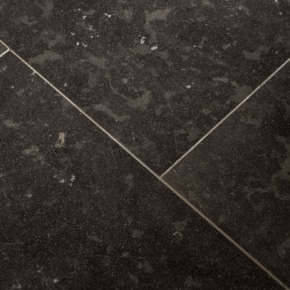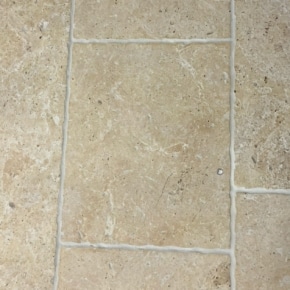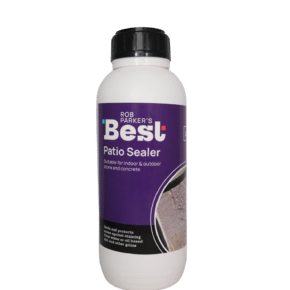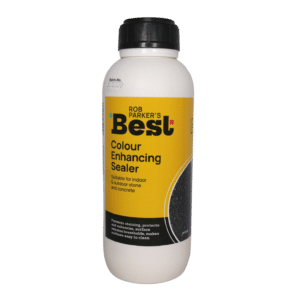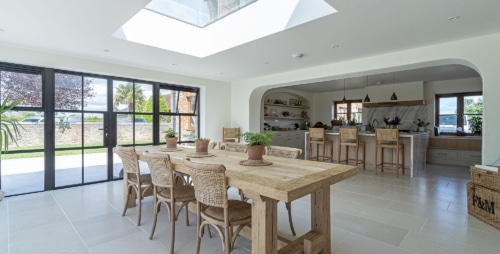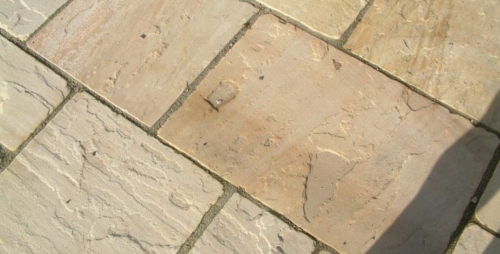This article compares large-format porcelain and natural stone for interiors. It covers where each works best, with guidance on formats, finishes and slip ratings (R10/R11), plus compatibility with underfloor heating.
You’ll also find a side-by-side comparison for kitchens, bathrooms, hallways and high-traffic areas, advice on colour and texture choices, and practical detailing for thresholds and stairs. A short aftercare section outlines simple maintenance plans and recommended products from Rob Parker’s Best.
Where large-format porcelain fits in contemporary interiors
Large-format porcelain tiles (900×900, 1200×1200, 1200×2400 and slab formats) suit pared-back, architectural schemes. Fewer joints mean calmer surfaces, easier cleaning, and a strong sense of continuity across open-plan spaces. Rectified edges support tight joints for a refined grid.
Performance is a core reason architects choose porcelain. Low porosity, high stain resistance and predictable slip ratings (e.g. R10/R11) make it reliable for kitchens, utilities and bathrooms. In high-traffic circulation, porcelain stands up well to wear without significant colour change.
Aesthetically, modern porcelains deliver concrete, terrazzo, stone or metal effects with consistent tonality. This helps when you need a specific look across multiple rooms or storeys. Where floors run into external terraces, a matched outdoor finish supports visual continuity and safer, higher-grip thresholds.



When to choose natural stone indoors
Natural stone (limestone, marble, quartzite, slate) brings depth and variation that manufactured surfaces cannot fully replicate. Subtle tonal shifts and veining patterns add character, especially in entrance halls, stair cores and living spaces where material honesty matters.
Stone ages with the building. Honed finishes develop a gentle patina under daily use, which many clients value for authenticity. Where performance is critical, specify denser stones and appropriate finishes to balance appearance with long-term durability.
Provenance is often part of the brief. UK stones support lower transport impact and heritage continuity. For limestone details, Stoneworld’s Park Lane Bath Stone can be used for internal cladding, stair components, fireplaces and bespoke pieces where a British material and consistent supply are required.
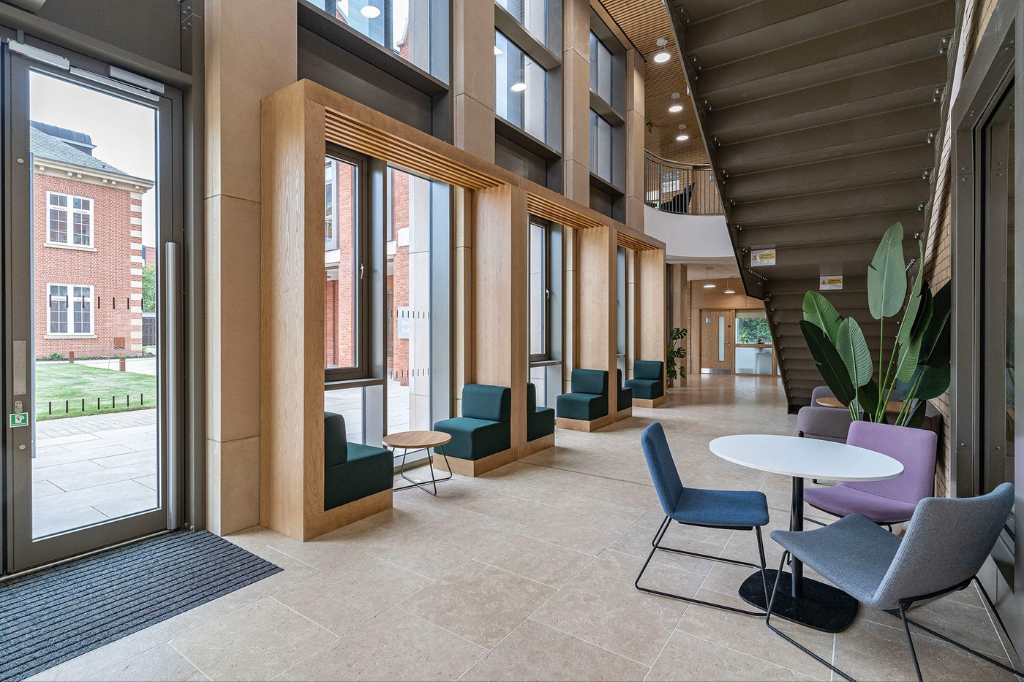


Porcelain vs natural stone: making the call
Think about the role of the surface first. For hard-working zones (family kitchens, utilities, kids’ bathrooms), porcelain’s stain resistance and predictable slip ratings are practical. In reception rooms and stair halls, natural stone gives presence and a richer acoustic quality underfoot.
Maintenance expectations matter. Porcelain needs routine cleaning; natural stone benefits from appropriate sealers and a simple care plan. Set this out at specification to manage client expectations and protect finishes over time.

Interior Porcelain
Stoneworld’s interior porcelain tiles suit contemporary spaces, with large-format sizes (900×900, 600×1200, 1200×1200 and up to 1200×2400) that reduce grout lines and create calm, continuous floors and walls. With low porosity, rectified edges and a typical 10 mm thickness, they’re straightforward to maintain, compatible with underfloor heating, and available in matt and lightly textured finishes for kitchens, hallways and bathrooms.
With our state of the art masonry shop we can cut and create anything you need with quality and precision.
Cost and programme also influence the decision. Porcelain offers consistent yield and can be easier to sequence on larger projects. Stone allows for bespoke formats, edge details and matching elements (treads, skirtings, cladding) that tie an interior together.
Natural Stone Interiors
Stoneworld’s natural stone flooring, wall cladding, and stair components bring depth and longevity to kitchens, hallways, and living spaces. Choose limestone, marble, or slate in honed or brushed finishes for a calm, refined look. All options are suitable for busy homes and work well with underfloor heating.
We fabricate thresholds, stair treads, skirtings, window cills, and vanity pieces to your drawings. Large-format tiles and slabs reduce joints for a cleaner finish, while consistent thickness helps deliveries and installation run smoothly.

Colour, texture and format for light and space
Neutral palettes (warm greys, buffs, soft beiges) support calm interiors and allow joinery and furniture to lead. Darker floors ground large rooms and work well with pale walls, while mid-tones are forgiving in high-use kitchens and hallways.
Texture is a design tool as well as a safety measure. Matt porcelains reduce glare under strong glazing. Honed stone gives a refined finish in living areas; brushed or lightly textured finishes add grip in kitchens and utility spaces without looking coarse.
Format planning shapes the perception of space. Large slabs reduce visual noise; running the same format into adjacent rooms supports continuity. Consider plank-format porcelains for linear emphasis, or combine large squares with stone skirtings and thresholds for quiet detailing.
Wet areas, kitchens and high-traffic zones
Bathrooms and wet rooms benefit from porcelain’s low water absorption and defined slip ratings. Use structured finishes (R11) for floors and smoother variants on walls to simplify cleaning. In showers, plan falls early and use matching profiles for tidy edges.
Natural stone can work well in bathrooms and kitchens with the right specification. Choose denser materials, avoid highly polished floors in wet areas, and seal appropriately. In utility spaces, consider stone on worktops or splashbacks where its depth adds interest against simpler cabinetry.
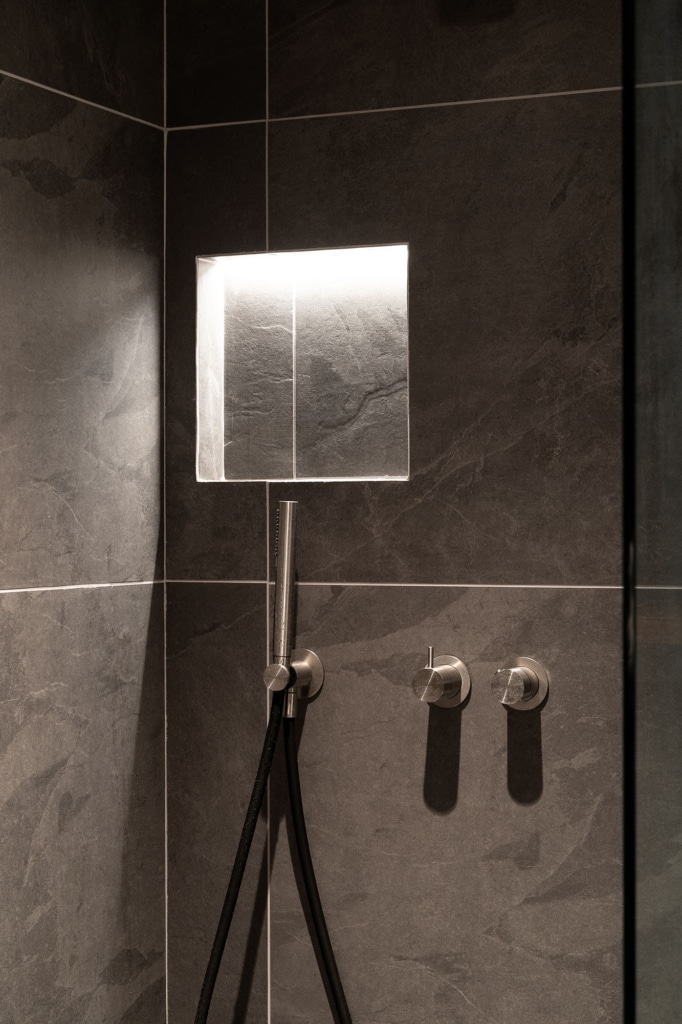
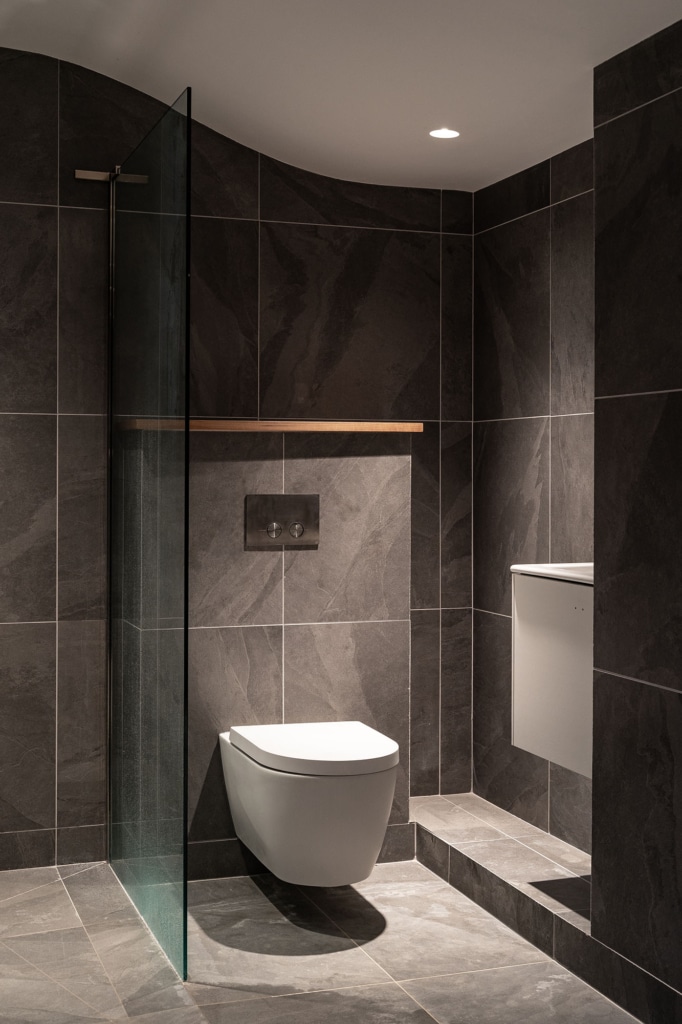
For everyday care, specify a basic maintenance plan with product recommendations. Rob Parker’s Best offers cleaners and treatments that help keep both porcelain and natural stone performing well over time.
Detailing: stairs, thresholds and transitions
Large-format porcelain and natural stone both lend themselves to clean stair detailing. Porcelain can be fabricated into mitred step edges for monolithic treads; stone treads can be supplied with pencil, chamfer or anti-slip nosings to suit usage and style.
Thresholds are a small line item with big impact. Matching formats and finishes across doorways keeps movement lines calm. Where interiors meet terraces, specify a practical external finish and consistent module to avoid awkward cuts.
Services and movement joints should be planned early. Align joints with room geometry, and coordinate trims, skirtings and upstands in the same material for a coherent finish across the project.



Bringing it together
Successful interiors balance calm surfaces with character. Use large-format porcelain tiles where you need consistent tone, low porosity and predictable slip ratings (R10/R11). Bring natural stone into key spaces for depth and variation, specifying honed or lightly textured finishes that work with underfloor heating and day-to-day use.
Plan details early: formats, joints, thresholds and stair edges make the difference between tidy and distracting. Source durable, responsibly supplied materials and agree a simple maintenance plan at handover so finishes keep performing.
If you’d like support, share drawings and room schedules. We can advise on product selection, slip resistance and edge profiles, provide samples, and match interior floors with external finishes for seamless transitions. For care products, pair your specification with Rob Parker’s Best. .




